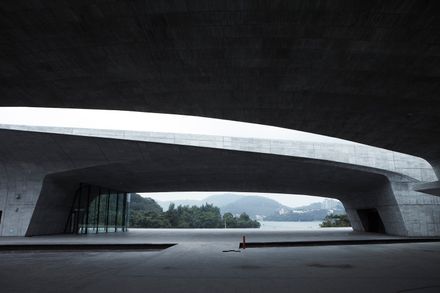
Sun Moon Lake Administration Office of Tourism Bureau
SUN MOON LAKE ADMINISTRATION OFFICE OF TOURISM BUREAU
Norihiko Dan And Associates
ARCHITECTS
Norihiko Dan And Associates
LANDSCAPE
Norihiko Dan And Associates, Su Mao-pin Architects
ELECTRICAL ENGINEER
Uichi Inouye Research Institute, Huan-chiou Electrical Engineering Co
STRUCTURAL ENGINEER
Structural Design Group, Horn Gyun Engineering Consultants Ltd
DESIGN TEAM
Norihiko Dan, Tadashi Yoshimura, Eiji Sawano, Minghsien Wang, Masato Shiihashi
ARCHITECT IN CHARGE
Norihiko Dan
PHOTOGRAPHS
Norihiko Dan And Associates, Anew Chen
SUPERVISION
Su Mao-pin Architects
AREA
6639 m²
YEAR
2013
LOCATION
TAIWAN
CATEGORY
Visitor Center, Cultural Architecture
Text description provided by architect.
Known as one of the main tourist spots in Taiwan, Sun Moon Lake in the Hsiangshan lake district has a certain calmness that is particularly East Asian.
In 2003, Norihiko Dan won the international competition for the Tourism Bureau’s Sun Moon Lake Administration office as a part of the “Landform Series.”
The basic policy was to present a new symbiotic example of the relationship between the architecture and its natural environment, which would refrain from destroying the surrounding landscapes, and bring out and expand the property’s potential strength as much as possible.
Buildings have been built on “top” of land since ancient times, but there are some that have been constructed directly in the land—such as the early Christian monasteries of Cappadocia, and the Yaodong dwellings of the Loess Plateau.
Thus, from a historical perspective, the relationship between architecture and landform has always been variable because it reflects the rich cultures of the location.
However, efficiency was the utmost priority for architecture in the twentieth century; less attention was paid to the relationship between landform and architecture.
Therefore, undulating land was carved and beautiful cliffs were filled to suit the convenience of architecture.
This particular project was designed to revise the relationship between architecture and its land, including the issue of waste soil disposal.
Consequently, the soil produced during the foundation construction was not disposed of but added to the volume of the building.
By allowing the building this autogenous deformation, the conceptually “soft” building and its volume integrate with the soil for an amalgam of half-architecture and half-landform.



















